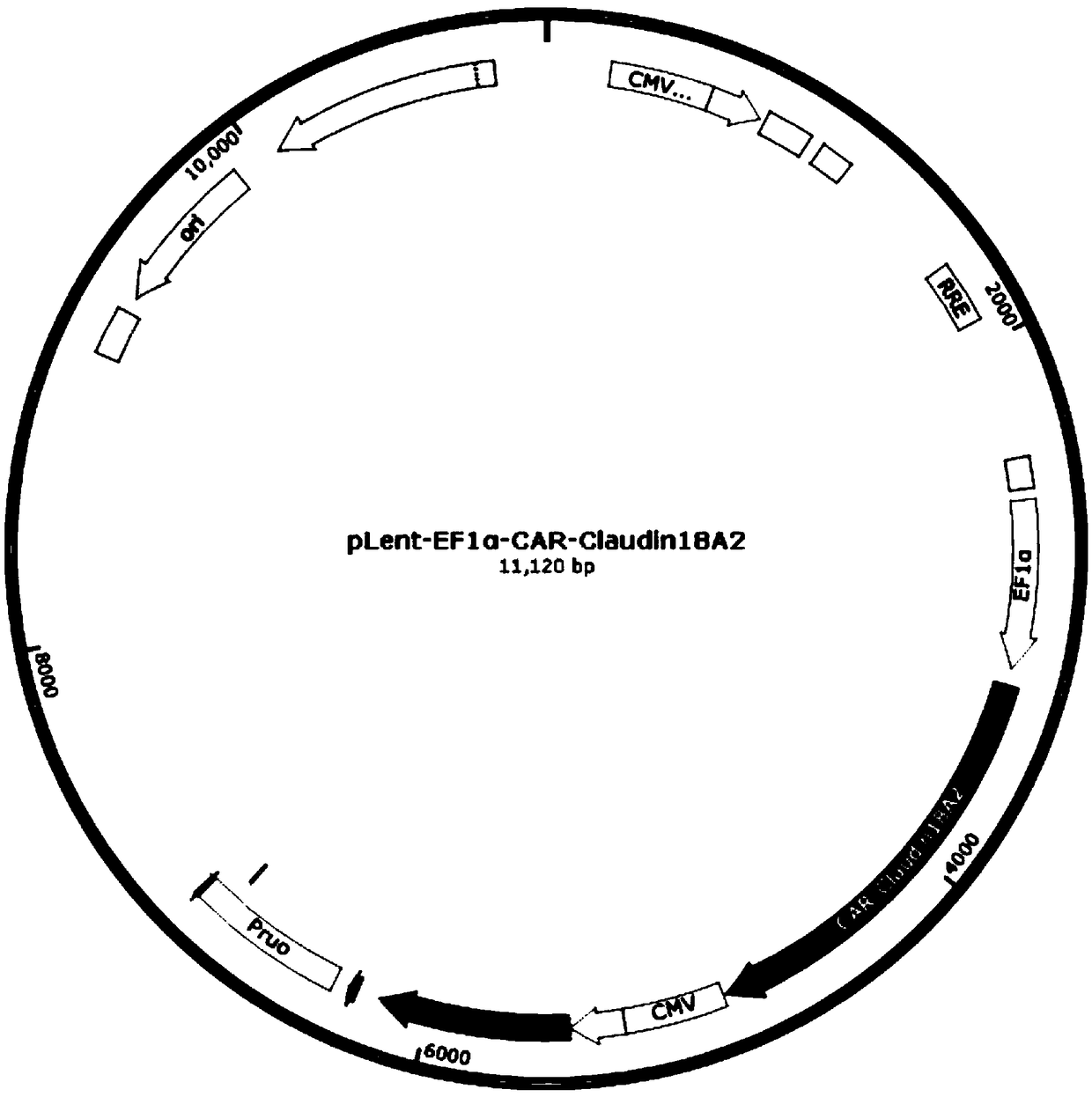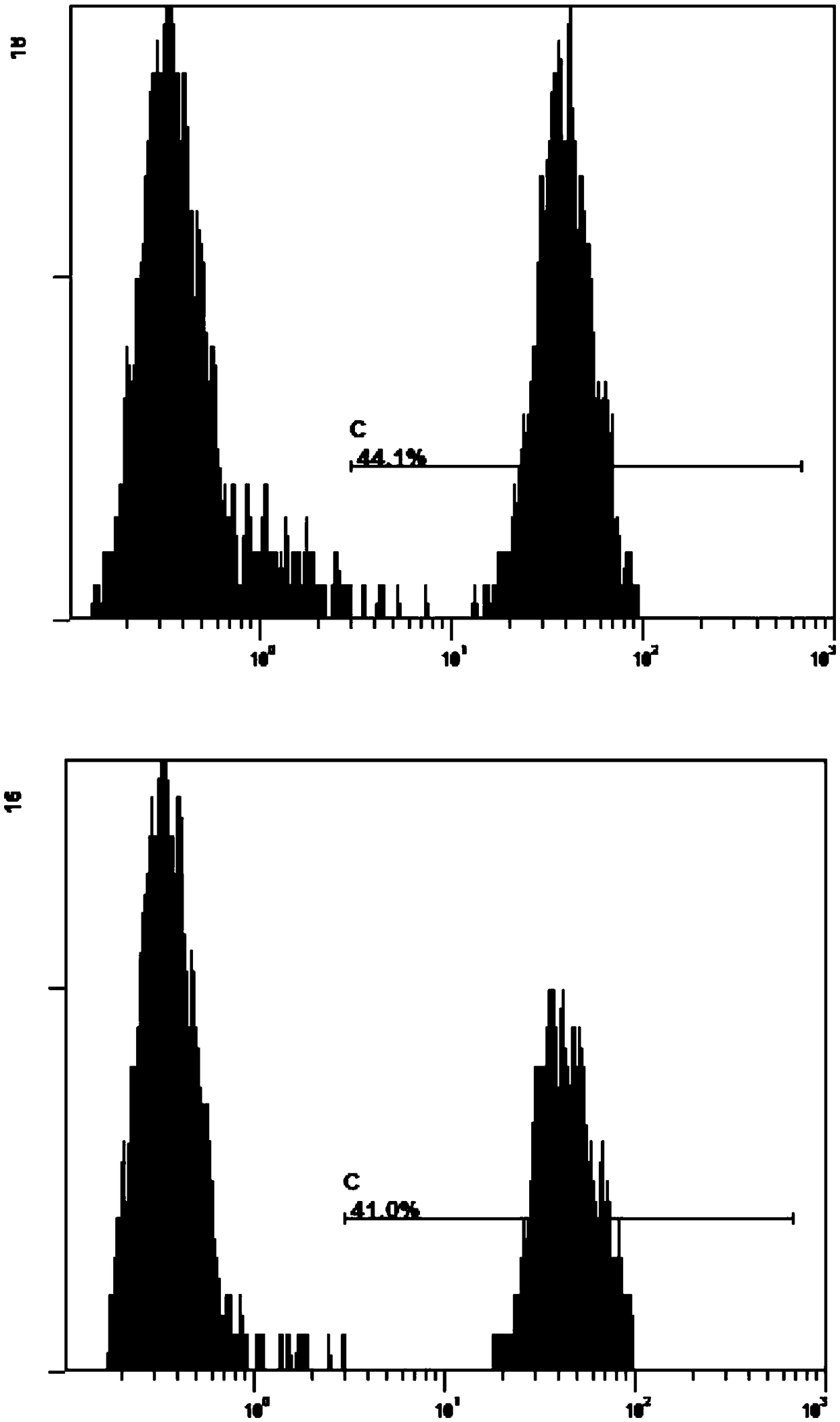Anti-Claudin18A2 chimeric antigen receptor, T cell modified thereby, and preparation method and application of T cell
A chimeric antigen receptor, cell technology, applied in the field of genetic engineering, can solve the problem of difficult technical improvement
- Summary
- Abstract
- Description
- Claims
- Application Information
AI Technical Summary
Problems solved by technology
Method used
Image
Examples
Embodiment 1
[0044] Anti-Claudin18A2 chimeric antigen receptor, including sequentially linked CD8αLeader, Claudin18A2 antigen-binding region, CD8 hinge region and transmembrane region, 4-1BB and CD28 co-stimulatory region, CD3ζ signal transduction region, the complete nucleic acid sequence is shown in the appendix SEQ ID NO.1.
[0045] Module sequence of CAR-Claudin18A2
[0046] (1) CD8α Leader (SEQ ID NO.2)
[0047] (2) Claudin18A2 antigen-binding region (SEQ ID NO.3)
[0048] (3) CD8Hinge region (SEQ ID NO.4)
[0049] (4) CD8 transmembrane region (SEQ ID NO.5)
[0050] (5) CD28 co-stimulatory region (SEQ ID NO.6)
[0051] (6) 4-1BB co-stimulatory region (SEQ ID NO.7)
[0052] (7) CD3ζ signaling region (SEQ ID NO.8).
Embodiment 2
[0054] The anti-Claudin18A2 chimeric antigen receptor is prepared by a method comprising the following steps:
[0055] (1) According to the order of Example 1 CD8α Leader, Claudin18A2 antigen binding region, CD8 Hinge region and transmembrane region, 4-1BB and CD28 co-stimulatory region, CD3ζ signal transduction region entrusted to Beijing Biomed Gene Technology Co., Ltd. to synthesize Its entire expression cassette (Claudin18A2 module indicated figure 1 ), and inserted into the cloning vector pUC57, the resulting product was named pUC-Claudin18A2,;
[0056](2) Carry out double enzyme digestion of pUC-Claudin18A2, use agar electrophoresis to cut off the agar part containing the Claudin18A2 DNA fragment, use the DNA extraction kit sol solution to treat, pass through the DF column and discard the filtrate, rinse the DF column, empty and elute DF column, and the centrifuged matter was collected to obtain a purified Claudin18A2 DNA fragment. In this example, the detailed steps ...
Embodiment 3
[0058] Construction of pLent-EF1α-CAR-Claudin18A2 expression vector
[0059] The recombinant expression vector was prepared by the following steps: the entire expression frame was synthesized according to the CD8α Leader, Claudin18A2 antigen-binding region, CD8 Hinge region and transmembrane region, 4-1BB and CD28 co-stimulatory region, and CD3ζ signal transduction region and inserted into pLent -EF1α vector (purchased from Vigene company) BamHI-NotI site (such as figure 2 ), transformed into E.coli (Top10), after the sequence was correct, the plasmid was extracted using the plasmid extraction kit of OMEGA Company, and the recombinant expression vector pLent-EF1α-CAR-Claudin18A2 was obtained.
[0060] The detailed steps of recombinant plasmid pLent-EF1α-CAR-Claudin18A2 are as follows:
[0061] According to CD8αLeader, Claudin18A2 antigen-binding region, CD8 Hinge region and transmembrane region, 4-1BB and CD28 costimulatory region, CD3ζ signal transduction region commissioned...
PUM
 Login to View More
Login to View More Abstract
Description
Claims
Application Information
 Login to View More
Login to View More - R&D
- Intellectual Property
- Life Sciences
- Materials
- Tech Scout
- Unparalleled Data Quality
- Higher Quality Content
- 60% Fewer Hallucinations
Browse by: Latest US Patents, China's latest patents, Technical Efficacy Thesaurus, Application Domain, Technology Topic, Popular Technical Reports.
© 2025 PatSnap. All rights reserved.Legal|Privacy policy|Modern Slavery Act Transparency Statement|Sitemap|About US| Contact US: help@patsnap.com



